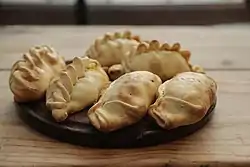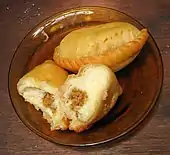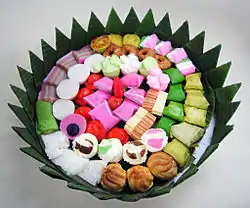Empanada
An empanada is a type of baked or fried turnover consisting of pastry and filling, common in Southern European, Latin American, and the Philippines cultures. The name comes from the Galician verb empanar, and translates as "enbreaded", that is, wrapped or coated in bread. They are made by folding dough over a filling, which may consist of meat, cheese, tomato, corn, or other ingredients, and then cooking the resulting turnover, either by baking or frying.
 | |
| Type | Pastry |
|---|---|
| Course | Appetizer |
| Place of origin | Unknown |
| Associated national cuisine | Spanish, Portuguese, Cape Verdean, Sicilian, Latin American, Indonesian, Filipino |
| Serving temperature | Hot or cold |
| Main ingredients | Meat, cheese, corn, or other ingredients |
| Variations | Pastel, pasty |
Origins
The origin of empanadas is unknown but they are thought to have originated in Galicia, a region in northwest Spain.[1][2][3] A cookbook published in Catalan in 1520, Llibre del Coch by Robert de Nola, mentions empanadas filled with seafood in the recipes for Catalan, Italian, French, and Arabian food.[4][5]
By country and region
Argentina
_caseras.JPG.webp)
Argentine empanadas are often served during parties and festivals as a starter or main course. Shops specialize in freshly made empanadas, with many flavors and fillings.
Every region of Argentina has its own characteristic variant.
Those of Salta are small, juicy and spicy, and contain potatoes, peppers and ground chili. The Jujuy variant adds peas and garlic. Its filling is called "recao" and the repulgue (the way of closing the empanada) "simbado". The La Rioja variant includes hard-boiled egg, red bell pepper, olives, and raisins. In Jujuy, there are two variants: "creoles" and "arabs". Those of Santiago are considered especially juicy. Those of Catamarca are similar but smaller. Tucumán is known for the empanada Creole; an annual "National Empanada" festival is held in Famaillá. Those of Famaillá are made with matambre and fried in good fat, competing with the "entreveradas" (mixed-grated), in which the matambre is mixed with chicken breast, garlic, ground chili, hard-boiled egg and cumin. Those of Mendoza are large and include olives and garlic. Those of San Juan add peeled tomato and white wine. In San Luis they are big, seasoned with oregano and hot pepper, and kneaded with pork fat. In Córdoba, they were called "federal cake" or "empanadas de Misia Manuelita", famous because pears boiled in wine with cloves were added to their filling. Today they are not so sweet but it is tradition to sprinkle them with sugar. In Traslasierra they add carrots and potatoes. In the Litoral, where immigrants from various parts of the world predominated, Santa Fe, Entre Ríos and Corrientes fill them with river fish, being delicious the surubí, dorado or with white sauce and Goya cheese. In the Cordillera of Patagonia, they are made with lamb and on the coast with seafood. In Buenos Aires, the Creole empanada is so important that it has been declared a Cultural Heritage of Food and Gastronomy by the Argentine Ministry of Culture.[6][7]
Belize

In Belize, empanadas are known as panades. They are made with masa (corn dough) and typically stuffed with fish, chicken, or beans.[8] They are usually deep fried and served with a cabbage or salsa topping. Panades are frequently sold as street food.[9]
Cape Verde
Cape Verde cuisine features the pastel, as well. Cape Verdean pastéis are often filled with spicy tuna fish. One particular variety, the pastel com o diabo dentro (literally: Pastel with the devil within), is particularly spicy, and is made with a dough made from sweet potatoes and cornmeal.[10]
Chile

In Chile, empanadas are a staple part of the national cuisine. Commonly consumed in large quantities during the country's national day celebrations, many Chileans consider this to be their most representative dish.[11] The most common type of Chilean empanada is what is referred to as the empanada de pino, it is a baked empanada filled with diced or ground beef sautéed with onions and spices, half of a hard boiled egg, an olive and raisins (although the latter is not liked by a sizable portion of the population). In the coastal regions of the country, seafood empanadas are also very popular.
Ecuador
Ecuadorian empanadas are called "empanadas de viento" and often fried and filled with stringy cheese and sometimes a touch of onion. Granulated sugar is sprinkled on top after cooking.
Indonesia

In Indonesia, empanadas are known as panada. It is especially popular within Manado cuisine of North Sulawesi where their panada has thick crust made from fried bread, filled with spicy cakalang fish (skipjack tuna) and chili, curry, potatoes or quail eggs. The panada in North Sulawesi was derived from Portuguese influence in the region.[12] This dish almost similar to karipap and pastel, although those snacks has thinner crust compared to panada.
Philippines

Filipino empanadas usually contain ground beef, pork or chicken, potatoes, chopped onions, and raisins (somewhat similar to the Cuban picadillo), though in a somewhat sweet, wheat flour bread. There are two kinds available: the baked sort and the flaky fried type. To lower costs, potatoes are often added as an extender, while another filling is kutsay (garlic chives).
Empanadas in the northern part of the Ilocos usually have savoury fillings of green papaya, mung beans, and sometimes chopped Ilocano sausage (chorizo) or longaniza and egg yolk. This particular variant is fried and uses rice flour for a crunchier shell.[13] There have also been people who make empanada filled with mashed eggplant, scrambled eggs, and cabbage, which they call poqui poqui.[14]
.jpg.webp)
In Bulacan, empanada de kaliskis (lit. "scale empanada"), uniquely has a flaky multilayered crust resembling scales, hence the name. In Cebu, empanada Danao is a characteristically sweet-savory variant. It is filled with chopped chorizo and chayote, deep-fried, and dusted in white sugar before serving. In Zamboanga, empanada Zamboangueño is filled with chopped sweet potato, garbanzo beans, and served with a sweet vinegar dipping sauce.[15]
Among the Tausūg people, empanada is known as pastil (not to be confused with the pastil of eastern Mindanao). It was introduced to the Tausūg via the Spanish in Zamboanga, and the name is derived from Spanish pastel ("pastry"). It can have a variety of fillings, including togue (mung bean sprouts), chicken Philippine adobo, various vegetables, and uniquely also pancit bihon (rice noodles). It is served with a sweet and spicy sauce.[16][17][18][19][20]
Dessert versions of empanada also exist. Notable ones include empanaditas, which commonly has a filling of latik (coconut caramel), honey and nuts, or peanut butter. Kapampangan versions of empanaditas have a yema (custard) and cashew nut filling. In Cebu, sinudlan empanada is a small deep-fried empanada with bukayo (sweetened coconut meat) filling.[15]
Sicily (Italy)

The 'Mpanatigghi are stuffed, consisting of halfmoon-shaped panzarotti filled with a mixture of almonds, walnuts, chocolate, sugar, cinnamon, cloves and minced beef.[21][22][23] These are typical of Modica, in the province of Ragusa, Sicily. They are also known as impanatiglie or dolce di carne (pasty of meat).[24]
They were probably introduced by the Spaniards during their rule in Sicily which took place in the sixteenth century; this is suggested from the etymology of the name which comes from the Spanish "empanadas or empanadillas" (empanada), as well as from the somewhat unusual combination of meat and chocolate, which occurs several times in the Spanish cuisine.[21][22][25] In past centuries for the preparation of 'mpanatigghi game meat was used but today beef is used.[21]
United States
Empanadas, mainly based on South American recipes, are widely available in New York City, New Jersey, and Miami from food carts, food trucks, and restaurants.[26] Empanadas are usually found in U.S. areas with a large Hispanic population, such as San Antonio[27][28] and Los Angeles.[29]
Similar foods
The empanada resembles savory pastries found in many other cultures, such as the pirozhki,[30] calzone,[30] samosa,[30][31] knish,[30][31] kreatopitakia,[30] Khuushuur, and pasty.[31]
In most Malay speaking countries in Southeast Asia, the pastry is commonly called karipap (English: Curry puff)
See also
| Wikimedia Commons has media related to Empanadas. |
References
- "Historia de la empanada criolla" (PDF). Dra. Susana Barberis. Retrieved 8 July 2010.
- Penelope Casas (1982), The Food, Wines, and Cheeses of Spain, Alfred A. Knopf, New York 1982 (p. 52)
- "Breve historia de la alimentación en Argentina". Liliana Agrasar. Retrieved 8 July 2010. They first appeared in medieval Iberia during the time of the Moorish invasions.
- Adamson, Melitta Weiss (2004). Food in medieval times. Greenwood Publishing Group. ISBN 0-313-32147-7.
- Lady Brighid ni Chiarain. "An English translation of Ruperto de Nola's Libre del Coch". Stefan's Florilegium. Retrieved January 31, 2011.
- "Empanadas: su origen y una historia extensa". misionesalinstante.com. Retrieved 2020-08-03.
- "El mapa definitivo de las empanadas argentinas con sus 14 versiones". www.lanacion.com.ar (in Spanish). 2018-10-05. Retrieved 2020-08-03.
- "Belizean Food". Belize.com. ITM Ltd. Archived from the original on 2015-12-02. Retrieved 1 December 2015.
- Kraig, Bruce; Sen, Colleen Taylor, eds. (2013). Street Food Around the World: An Encyclopedia of Food and Culture. Santa Barbara, California: ABC-CLIO. p. 72. ISBN 978-1-59884-954-7.
- Hamilton, Cherie. Cuisines of Portuguese Encounters, Hippocrene Books. 2001.
- Larrain, Jorge (2001). Identidad chilena. LOM Ediciones. ISBN 9789562823999.
- https://www.indonesiakaya.com/jelajah-indonesia/detail/panada-kue-lezat-peninggalan-bangsa-portugis-di-Manado
- Ian Ocampo Flora (April 23, 2010). "Vigan Empanada and the gastronomic treats of Ilocos". www.sunstar.com.ph. Archived from the original on 5 May 2010. Retrieved 30 December 2010.
- News, Ria Galiste, ABS-CBN. "Look: Restaurant adds twist to Ilocos empanada". ABS-CBN News. Retrieved 2019-05-31.
- Polistico, Edgie (2017). Philippine Food, Cooking, & Dining Dictionary. Anvil Publishing, Inc. ISBN 9786214200870.
- "Pastil". Savor Filipino Foods. Retrieved 9 March 2020.
- "How to Eat Pastil". A Hijab's Cup of Tea. Retrieved 9 March 2020.
- "Pastel". Philippine Food Illustrated. Archived from the original on 2017-10-26. Retrieved 14 December 2018.
- "How to Eat Pastil". A Hijabi's Cup of Tea. Retrieved 9 March 2020.
- "The Satiety of Satti (and more): A Taste of Tausug Delicacies in Zamboanga". Bob Trail Tales. Retrieved 9 March 2020.
- Red. Spe. (31 July 2013). "Quanto è "dolce" Ragusa". Corriere del Mezzogiorno.
- Giovanni Assenza (2014). Miele, garofano, cannella. I profumi dei dolci di Sicilia. Assenza. ISBN 978-605-030-594-4.
- Nicky Pellegrino (2013). The Food of Love Cookery School. Hachette UK. ISBN 978-1-4091-3381-0.
- Monica Cesari Sartoni (2005). Mangia italiano. Guida alle specialità regionali italiane. Morellini Editore. ISBN 88-89550-05-8.
- Touring Club of Italy (2005). Authentic Sicily. Touring Editore. ISBN 88-365-3403-1.
- "10 Spots To Score Excellent Empanadas In NYC" Archived 2016-07-08 at the Wayback Machine by Angely Mercado, Gothamist, 13 October 2014;
"NYC Food Truck Lunch: Empanadas From La Sonrisa Empanadas" by Perry R., CBS New York, 9 October 2015 - "The 15 Best Places for Empanadas in San Antonio". FourSquare. Retrieved January 4, 2017.
- Rice, Janae. "Finding Empanadas in SA". San Antonio Current. Retrieved January 4, 2017.
- Chabala, Tracy. "5 Great Baked Empanadas in Los Angeles". LA Weekly. Retrieved January 4, 2017.
- Glenn Randall Mack & Asele Surina, Food Culture in Russia and Central Asia (Greenwood, 2005), p. 138.
- Patricia Yeo & Julia Moskin, Cooking from A to Z (St. Martin's Press, 2002), p. 53.
External links
 Media related to Empanadas at Wikimedia Commons
Media related to Empanadas at Wikimedia Commons

